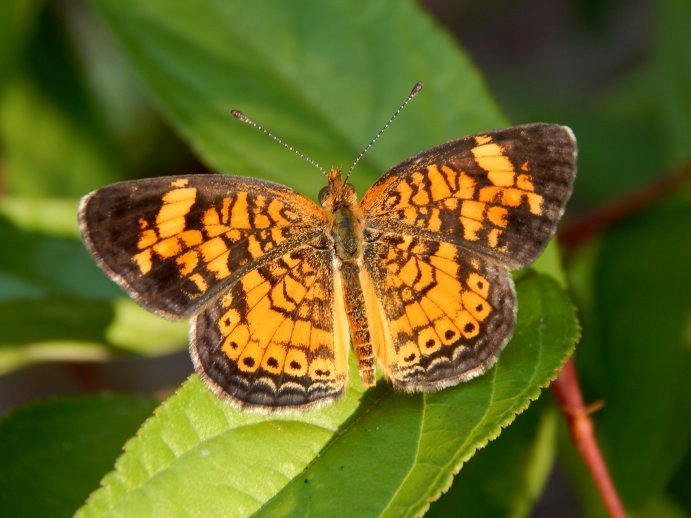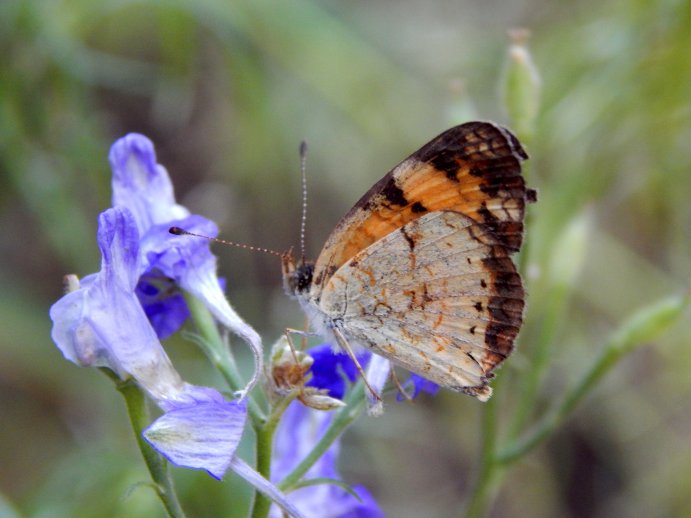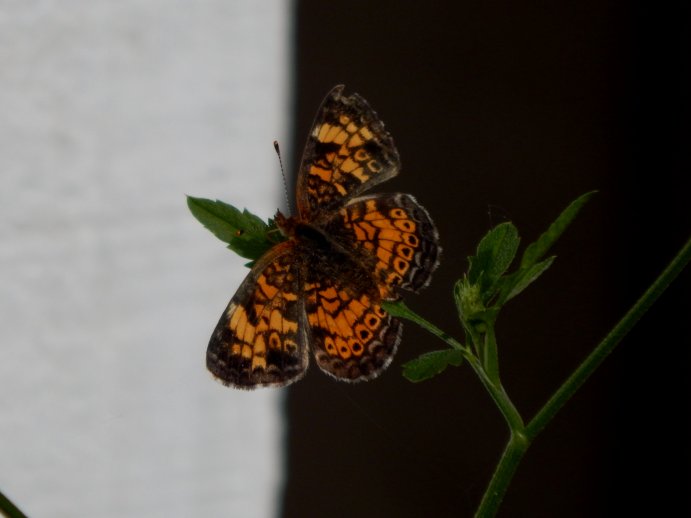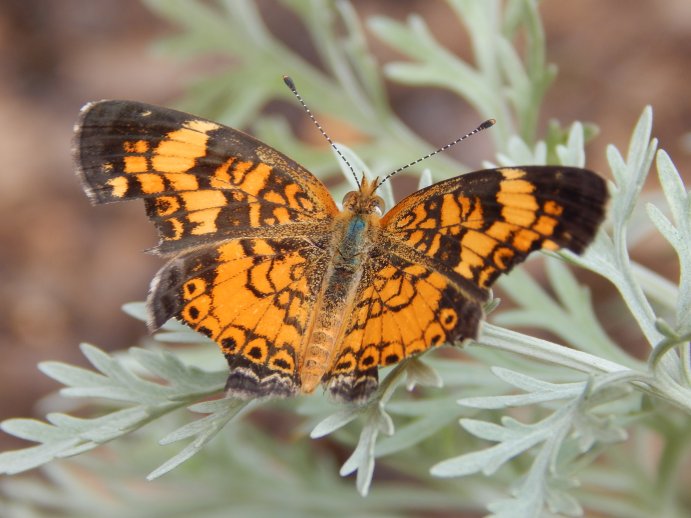
Welcome to my Butterfly Bucket List for July 2015. This month I’m highlighting the Pearl Crescent (Phyciodes tharos), a small butterfly that’s been flitting about in my garden since late spring. Its average wingspan is about 1.5 inches (approximately 3.8 cm). The Pearl Crescent is an orange and black butterfly, colors which appear to be very common in this part of the country as far as butterflies are concerned!

These butterflies flit around all over the place, rarely sitting still long enough to get close enough for a good photograph. I usually find them during the mid-afternoon when the sun is really beating down on the vegetation. They tumble from one plant to another looking for nectar or just to bask in the sunshine. When one finally comes to rest I make a stealthy approach and take a few quick shots while I’m several feet away…just in case it decides to flutter away before I can get near enough for a good close-up. Then I creep a little further, get the camera as close as I can, and begin snapping away until the butterfly takes off again. I never figured I’d become…the Butterfly Stalker!

Pearl Crescent Butterfly Facts
- Adult Pearl Crescents feed on nectar from a variety of different plants including: Black-Eyed Susan (Rudbeckia hirta), Butterfly Weed (Asclepias tuberosa), Shepherd’s Needle (Bidens alba), Sedum (Sedum spectabile), Aster (Aster) and Purple Coneflower (Echinacea purpurea).
- Caterpillar hosts include Frost Aster (Aster pilosus), Texas Aster (Aster texanus) and Smooth Blue Aster (Aster laevis).
- The Pearl Crescent is found just about everywhere in the United States except for the west coast.
- Pearl Crescents are brush-footed butterflies of the Nymphalida family.
This Pearl Crescent butterfly looks like he may have escaped the clutches of a predator at one point. He’s lost bits and pieces of his wings.

I’m especially intrigued by the butterfly’s antennae. The colors seem to alternate black and white. They’re very attractive! They also come in very handy. According to Gardens With Wings:
“Butterfly’s have one pair of segmented antennae. The basic shape is clubbed, meaning the segments increase in size as it gets further away from the head. For butterflies, this usually creates a club like appearance on the tip of the antenna. Butterfly antennae have chemoreceptors that are used for assessing the environment’s physical and chemical properties. Chemoreceptors are similar to the taste buds on our tongues. They are open nerve endings that transport the information to their central brains for translation. For example, butterflies use their antennae to detect which plants are producing nectar and males can sense pheromones from females of the same species. Near the base of the antennae, in the second antennal segment, there is also a very important organ called Johnston’s organ. It is used for balance and orientation during flight. With an antenna lacking, butterflies may be unable to fly in a particular direction and may end up flying in a circular pattern.”
Thanks for visiting my Butterfly Bucket List post for the fourth Sunday of July. If you’d like to take part please do so! The meme posting day is the 4th Sunday of each month, but that’s not a hard-and-fast rule. Feel free to post your sightings any time within the following week. Just put a link to your post in the comment section of this post. I look forward to seeing the butterflies, moths and caterpillars that have stopped by your garden during the past month!










The fourth Sunday! Gosh the month of July flew-just like those Pearl Crescents in my gardens that I haven’t been able to photograph. Your photos are beatiful, though. Thanks for the good information and picture treats. I love this meme.
LikeLike
This entire year is just flying by! I don’t know where the time goes. Glad you enjoyed the photos. Join in any time!
LikeLike
I have never been able to catch these beauties…they sometimes appear in my garden and when they do I rejoice! I won’t have a butterfly post until next Monday…and I will still link back!
LikeLike
Patience, that’s all I can say! I look forward to your post. 🙂
LikeLike
Here is my post….hope you enjoy….it is part of a larger post so the butterflies are near the end.
http://gardenseyeview.com/2015/08/03/gardens-eye-journal-august-2015/
LikeLike
I did enjoy, thanks! Loved the entire post.
LikeLike
[…] the end of each month the transmutational garden hosts a butterfly bucket list event. It is a great excuse […]
LikeLike
Great photos — especially since as you say they don’t like to pose for anyone. So many of the butterflies I see have really tattered wings that make me wonder how they can fly at all. I have found wing pieces lying on the ground and they seem so very delicate. I suppose they just wear out over time. In some cases as you note they tell the story of close escapes.
LikeLike
I read somewhere that butterflies can still fly with 75% of their wings gone (I suppose that means on both wings) but I find that difficult to believe. I am amazed though at how often I see them with their wings tattered like this. Rough life being a butterfly!
LikeLike
I have seen few butterflies but I do see this one..thank you for all the info..Michelle
LikeLike
These are very populous around here! I see them every day, it seems.
LikeLike
Not a new post, but a post about raising monarchs from egg to butterfly.. http://ramblingwoods.com/raising-butterflies-from-egg-to-release/raising-monarch-butterflies/
LikeLike
Thanks for adding the link. I’ve never thought about raising butterflies, but I would think it would be quite interesting. I look forward to reading your post!
LikeLike
This is actually a page I have at the top of the blog. I never raised a butterfly until 2011 and haven’t raised many. But there is something magical about it..
LikeLike
Wow, that was just an incredible read! Great pictures and descriptions of the nurturing process!
LikeLike
Lovely photos! Thanks for having such informative posts. I think I learn the name of something familiar every time I read your writing.
LikeLike
Thanks! I’m glad you’re learning something right along with me. Every time I find a new (or not so new) bug I have to dig up all I can about it. They’re so interesting, especially the butterflies.
LikeLiked by 1 person
They are a beautiful butterfly, I have managed to see my first Gatekeeper butterfly to day…
Amanda xx
LikeLike
I had to look that one up! They’re quite lovely.
LikeLike
Pearl Crescents are hard to capture in a photo.
I found your Meme just hours after I made a post on recent butterflies visiting here:
http://seedscatterer.blogspot.com/2015/07/more-broods-of-butterflies.html
I linked back but did not post your image. Is that okay?
LikeLiked by 1 person
They are flighty little things, aren’t they!? Thanks for linking your post and don’t worry about the image. I’m just glad to see your wonderful photos!
LikeLike
Pretty images. Pearl crescents can certainly give you a workout. They have an annoying habit of perching prettily and then moving on when they sense motion. They have several flights per year – you’ll have many more to chase.
LikeLike
I think they’ve been here continuously for several months at least. They don’t like to be photographed, do they? They’re one of the more reliable butterflies to see around this area. They’re also mingling with a few Texan Crescents.
LikeLike
Cool – southern areas have many more species than up here in the northeast. You should try blues and coppers!
LikeLike
I think if I’d get out of my backyard and into the parks I might find more!
LikeLike
I love your photographs but wonder if you take all of your own? If so, you live in a diversified Eco-system.
LikeLike
Yep, I take all of my own photos. Probably 95% are from my backyard/garden, which is quite small. The wildlife and plant life around here is pretty diversified…if you look close enough! The insects and butterflies don’t come looking for you, you have to search them out most of the time! It helps to have native plants that grow in this heat and dryness, as well as multiple bird feeders, etc. It really is amazing what lurks around in our yards and gardens!
LikeLike
These photos are great, Anna. I’m pretty sure I have a good idea of how much effort you are putting into this considering all the great shots you are capturing, and hat’s off lady! Really well done.
And now, for something a bit different… Late and riddled with inaccuracy, but here is my attempt to participate in the Bucket List! Thanks for host(ess)ing.
http://austinagrodolce.blogspot.com/2015/07/name-that-butterfly.html
LikeLike
Thanks! I have so much fun taking the photos, especially in this heat. Ha! Your post is great — love your mystery Skippers. Maybe between all of us we can help identify them!
LikeLike
Wow, amazing information about the antennae. Lovely series of pictures. Butterflies often seem to be a bit weather-beaten and I never notice until looking at the photos later.
LikeLike
Yes, the antennae info was interesting to me, too! Insects are just amazing. And I am amazed at how many of the butterflies I have photos of have pieces missing from their wings or are scratched up.
LikeLike
An interesting, and informative, post with wonderful pictures. xx
LikeLike
Thank you!
LikeLike
beautiful!!!
LikeLike
Thanks, I think so, too! I love the colors.
LikeLike